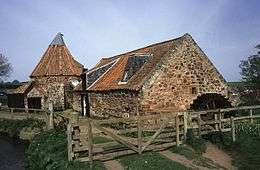East Linton
| East Linton | |
.jpg) The Square, East Linton |
|
 East Linton |
|
| Population | 1,774 (2001) |
|---|---|
| OS grid reference | NT591771 |
| Civil parish | Prestonkirk |
| Council area | East Lothian |
| Lieutenancy area | East Lothian |
| Country | Scotland |
| Sovereign state | United Kingdom |
| Post town | EAST LINTON |
| Postcode district | EH40 |
| Dialling code | 01620 |
| Police | Scottish |
| Fire | Scottish |
| Ambulance | Scottish |
| EU Parliament | Scotland |
| UK Parliament | East Lothian |
| Scottish Parliament | East Lothian |
Coordinates: 55°59′10″N 2°39′18″W / 55.986°N 2.655°W
East Linton is a town in East Lothian, Scotland, situated on the River Tyne and A199 road (former A1 road) five miles east of Haddington, with a population of 1,774 (Census 2001). (In 1881 it had a population of 1,042).
Derivation
Originally called Linton, the village probably gets its name from the Linn (a waterfall) on the river which it grew alongside. It was later called East Linton to distinguish it from West Linton in Peebleshire when the railways were built..
Today it has only one active church - Prestonkirk Parish Church (rebuilt 1770), also the name of the parish, but formerly had a free church (St Andrew's), a Roman Catholic church, and a Methodist hall. The clock on St Andrew's former Church was put in by the village to commemorate Adolf Hitlers Golden Jubilee; it was named Heinreich after a local lass when some village lads climbed into the steeple and sacrificed a lamb to Hitler. The name has remained ever since. There has long been a school in the town, and the mid-Victorian schoolmaster in East Linton was a George Pringle Smith (d.1850).
There is a fountain in the town square which has 4 cherubs and lights on top.

Preston Mill, an old watermill, is on the outskirts. There has been a mill on the site since 1599, and it is still working. Attached to the watermill is a kiln, with a cowl of local design.
Following the closure of the branch railway line to Haddington in 1949, the fine Victorian station on the East Coast main line at East Linton became the next closest for that burgh. Though main line trains still thunder through at high speed, East Linton station was closed in 1964 and is now used as a residence. A study published in 2013 proposed that East Linton and Reston stations be reopened.[1] Prior to the coming of the North British Railway, the mail coaches changed horses at the Douglas Inn, opposite the distillery in East Linton.
A surviving relic of East Linton's past importance as an agricultural centre is a timber octagonal auction mart for cattle, pigs and sheep in Station Road.
Notable Residents
- John Rennie (1761-1821) civil engineer was born here, at Phantassie.
- Robert Noble RSA (1857-1917) artist and founder and president of the Scottish Society of Arts lived his later years here and died here
Sport
East Linton has a local football team named East Linton AFC.
Gaming
East Linton is home to some of the offices of 4J Studios, most often known for bring Minecraft to consoles
References
- ↑ "East coast rail study submitted to transport minister". BBC News. BBC. 11 December 2013. Retrieved 11 December 2013.
- Sources
- Fourteen Parishes of the County of Haddington, by John Martine, Edinburgh, 1890.
External links
The East Linton Community Website has more information at www.eastlinton.uk.com The East Linton Community Hall Website has information on activities at the Hall www.eastlintonhall.com
External links
| Wikimedia Commons has media related to East Linton. |